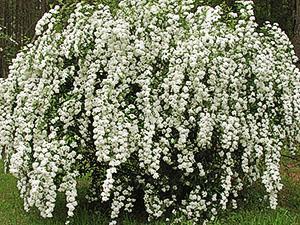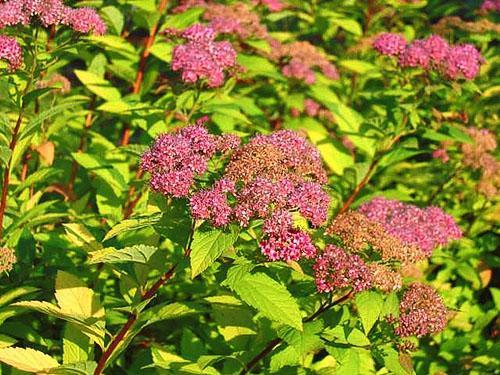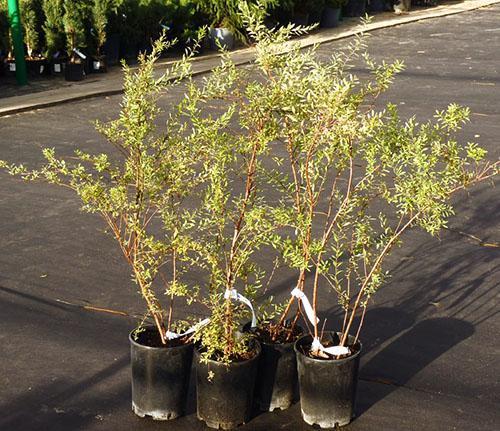How to plant a spirea and organize proper plant care
 Novice and experienced gardeners love spirea bushes for their attractive and beautiful appearance, fast growth rate, winter hardiness and ease of maintenance. Shrubs are divided into two categories: blooming in spring and summer. In spring, a spirea blooms with thin, curved branches and large clusters of white flowers in a cascade. In summer, the bush has pink, white, or red flowers on vertical shoots. Both varieties are prized for their shapes and vibrant colors. The flowering period is about 6 weeks. An original bush, with many branches, which are densely covered with white flowers, is called "May snow", "bride".
Novice and experienced gardeners love spirea bushes for their attractive and beautiful appearance, fast growth rate, winter hardiness and ease of maintenance. Shrubs are divided into two categories: blooming in spring and summer. In spring, a spirea blooms with thin, curved branches and large clusters of white flowers in a cascade. In summer, the bush has pink, white, or red flowers on vertical shoots. Both varieties are prized for their shapes and vibrant colors. The flowering period is about 6 weeks. An original bush, with many branches, which are densely covered with white flowers, is called "May snow", "bride".
Is it difficult to grow?

Preparing for landing
 According to the advice and observations of gardeners, spirea develops well in sunny areas, with loose, fertile soil. Ornamental shrubs should be planted taking into account the design of the site. Please note that the distance between plants when planting in the form of a hedge is kept at least 50 cm.With a single arrangement, this distance can be increased. The root system must be prepared before planting. If it is open, then the damage on the processes is clearly visible, which must be removed with a sharp garden pruner.
According to the advice and observations of gardeners, spirea develops well in sunny areas, with loose, fertile soil. Ornamental shrubs should be planted taking into account the design of the site. Please note that the distance between plants when planting in the form of a hedge is kept at least 50 cm.With a single arrangement, this distance can be increased. The root system must be prepared before planting. If it is open, then the damage on the processes is clearly visible, which must be removed with a sharp garden pruner.
The cut angle should be even, clear, and not wrinkled or scaly.
Be sure to correct the crown of the bush. The regrown branches should be shortened by a third. With very dry roots, the shoots are cut off a little more. When purchasing a spirea with an earthen lump on the root system, it will need abundant watering so that it softens and only after that it will be possible to lower it into a planting hole.
Landing
 A separate hole is dug under each plant, or a trench is dug. The width is chosen based on the volume of the root system, usually 50 × 50 cm. It is necessary to dig a depression in advance so that the pit dries out and airs out. The depth of the hole is made 50 cm. The plant is lowered into it so that the root collar is at the level of the soil surface. Prepare a mixture for falling asleep in the pit:
A separate hole is dug under each plant, or a trench is dug. The width is chosen based on the volume of the root system, usually 50 × 50 cm. It is necessary to dig a depression in advance so that the pit dries out and airs out. The depth of the hole is made 50 cm. The plant is lowered into it so that the root collar is at the level of the soil surface. Prepare a mixture for falling asleep in the pit:
- sand;
- Earth;
- peat.
The proportions are 1: 2: 1. It is necessary to straighten the roots in the pit and then cover with soil mixture. Loosely trample the ground around the bush and mulch with peat. It is preferable to carry out garden work in autumn, September, early October. Transplanting spirea in the fall will allow the plant to harden before the onset of frost.
Rules for caring for a garden spirea shrub
 Planting and maintenance is of particular importance for those looking for a beautifully flowering shrub. This is achieved by properly selected and prepared soil. On scanty land, it will not be possible to form a lush and spreading spirea bush.
Planting and maintenance is of particular importance for those looking for a beautifully flowering shrub. This is achieved by properly selected and prepared soil. On scanty land, it will not be possible to form a lush and spreading spirea bush.
Clay soils when planting spirea require mandatory laying of drainage from bricks, gravel and sand of at least 15 cm.
Spirea is unpretentious, it endures severe frosts and dry weather.The plant is not susceptible to attacks by garden pests and diseases. Loosening is not included in the mandatory list and is purely aesthetic in nature.
It is advisable to cover a spirea seedling planted in autumn with a special material so that it can more easily endure winter low temperatures.
Watering
 Spirea, planted in spring, has not yet developed its root system, therefore it needs regular soil moisture. During the dry summer months, abundant watering flowering varieties of spirea. Wet ground around the shrub will provide favorable conditions and allow the spirea to grow stronger. Spirea, covered with flowers in spring, does not depend much on regular soil moisture. The exception is those seedlings that have been planted recently.
Spirea, planted in spring, has not yet developed its root system, therefore it needs regular soil moisture. During the dry summer months, abundant watering flowering varieties of spirea. Wet ground around the shrub will provide favorable conditions and allow the spirea to grow stronger. Spirea, covered with flowers in spring, does not depend much on regular soil moisture. The exception is those seedlings that have been planted recently.
Additional convenience will be given by mulching the soil. It will keep the soil moisture under the bush longer. The roots are close to the surface; in the summer months, 15 liters of water is enough for each bush twice a week.
Top dressing
 Fertile soil is already a good basis for growth and development, so fertilization is not as important as in poor and scarce soils. Spirea is fed in early spring. After pruning, mineral fertilizers (complex) are applied. In the middle of summer, mullein and 10 g of superphosphate are used for each plant.
Fertile soil is already a good basis for growth and development, so fertilization is not as important as in poor and scarce soils. Spirea is fed in early spring. After pruning, mineral fertilizers (complex) are applied. In the middle of summer, mullein and 10 g of superphosphate are used for each plant.
Pruning
 For a beautiful crown and lush flowering, it is necessary to periodically clean the bush from dead, sick and broken branches at any time of the year. Spirea can be seriously pruned and it will only benefit her. Pruning spirea in autumn is most preferable. The plant is preparing for the winter season and the extra branches will weaken the bush in the spring. When pruning the spirea after winter, pay attention to the tips of the shoots. It is necessary to remove those that are frozen. This procedure will ensure a beautiful bloom.
For a beautiful crown and lush flowering, it is necessary to periodically clean the bush from dead, sick and broken branches at any time of the year. Spirea can be seriously pruned and it will only benefit her. Pruning spirea in autumn is most preferable. The plant is preparing for the winter season and the extra branches will weaken the bush in the spring. When pruning the spirea after winter, pay attention to the tips of the shoots. It is necessary to remove those that are frozen. This procedure will ensure a beautiful bloom.
A shrub that blooms in summer is pruned with the onset of spring. Those that bloom in spring are subjected to this procedure immediately after the end of flowering. On plants more than 10 years old, it is necessary to remove all signs of aging in order for it to form a new crown. Usually the life of the shrub is 20 years.
Some gardeners consider pruning spirea to be an unnecessary task. In this case, you run the risk of getting unkempt thickets with a lot of dry branches and weak flowering.
Reproduction

The spiraea plant is very convenient and unpretentious, reproduction is carried out in several ways: by cuttings, shoots and seeds, and the latter option is not suitable for hybrid plants, since seeds do not appear on them or do not have signs of a mother bush.
Spring is the best time to plant seeds. They are buried in high moor peat and moisturized well. Germination will take 10 days. Further, they are subjected to a pick when transplanted with a spirea in open ground, cloudy weather or evening is needed. Provides mulching and regular watering. For a year, the spirea can grow up to 10 cm in height. The first flowering can be expected at 3 years of plant life.
For the propagation of spirea by cuttings, woody shoots or very young ones are used - green. For spirea blooming in spring, cuttings are used in June, and summer plants in July. For the development of the root system, the cutting is well watered and kept in conditions of high humidity. Spring and the first leaves are the time for branch breeding. The lower branches are bent to the ground, pinned with a wire bracket and sprinkled with soil. Regular watering will ensure good rooting and independent shrubs will form in the spring. Sprinkle with dry foliage for the winter.
Spirea looks great in picturesque compositions and is rightfully popular among gardeners and landscape designers. Lush flowering shrubs are eye-catching and eye-catching.